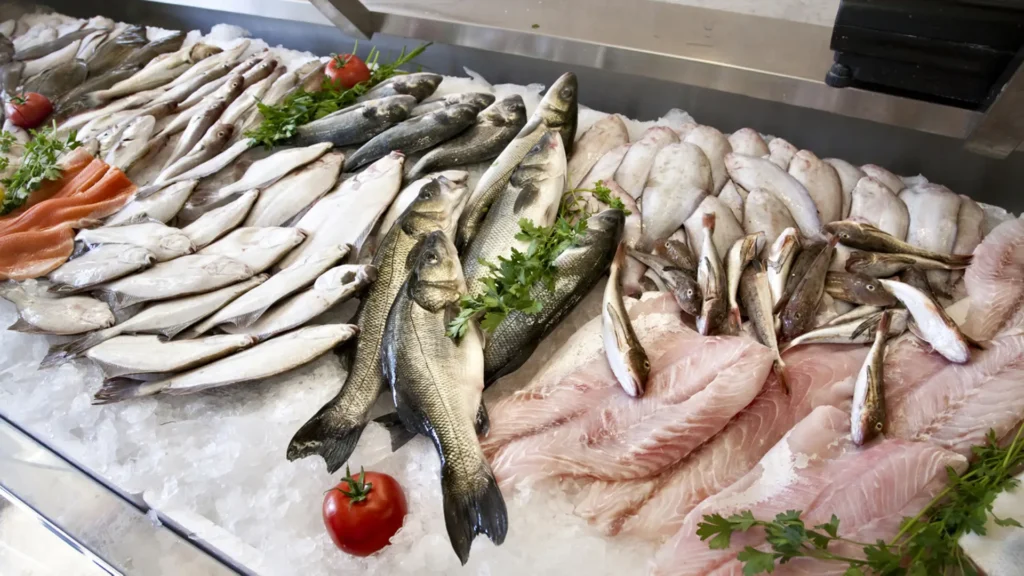When you’re browsing the aisles of your favorite market, you might wonder how to choose seafood that doesn’t just taste good, but is also good for the oceans. Start by checking for eco-certifications like MSC (Marine Stewardship Council) or ASC (Aquaculture Stewardship Council) on the packaging; these labels indicate that the seafood market meets specific sustainability standards. Also, don’t hesitate to ask the fishmonger about the source of the fish and the fishing practices used. They’re often an untapped wealth of information and can guide you toward the best choices. However, there’s another layer to this—knowing the seasonal cycles of seafood can enhance your sustainable practices even further.
Understanding Seafood Labels
Understanding seafood labels is crucial for choosing sustainably sourced options. When you’re at the store, scanning labels, you need to know what to look for to ensure you’re making ethical choices.
Firstly, check for sustainability certifications like the Marine Stewardship Council (MSC) or Aquaculture Stewardship Council (ASC). These labels indicate the seafood was harvested or farmed with practices that consider environmental impact and fish populations.
Next, pay attention to the traceability of the seafood market. Labels that include detailed information about where and how the fish was caught or farmed can guide you towards more transparent and responsible choices. Look for specifics like the ocean or farm location, and the method used for catching or farming.
You also should be wary of vague terms like ‘sustainably sourced’ without any certification. These can be misleading and are often used as marketing tools rather than genuine indicators of sustainability. Instead, seek out labels that provide verifiable claims backed by reputable organizations.
As you shop, use these insights to navigate the complex waters of seafood labeling. By doing so, you’re not only supporting sustainable practices but also contributing to the health of our oceans.
Seasonal Seafood Guide
Now, let’s explore how choosing seafood market based on the season can further enhance your sustainable shopping practices. Aligning your seafood purchases with the natural growth and harvest cycles ensures that you’re not only getting the freshest catch but also supporting the health of marine ecosystems.
For instance, buying wild salmon during its peak season, which generally runs from May through September, means you’re getting fish at its nutritional best and helping to prevent overfishing during vulnerable times.
You’ve got to look out for local seafood calendars, usually available at markets or online, which guide you through what’s in season in your area. This not only boosts local economies but also reduces the carbon footprint associated with long-distance seafood transport.
Moreover, when you opt for a seasonal seafood market, you’re more likely to encounter a variety of species, which can introduce you to new flavors and dishes. This diversification also helps in distributing fishing pressures across different species throughout the year.
For example, instead of opting for the usual cod, why not try pollock or haddock when they’re in season? These choices often come with a lower price tag due to their abundance during peak seasons, making sustainable choices easier on your wallet as well.
Choosing Responsible Retailers
When selecting where to buy your seafood, it’s crucial to choose retailers that prioritize sustainable practices and transparent sourcing. You’ll want to look for markets that can provide detailed information about where and how their seafood was caught or farmed. This transparency is a key indicator that they’re committed to ethical environmental practices.
Ask if the retailer is certified by recognized organizations like the Marine Stewardship Council (MSC) or the Aquaculture Stewardship Council (ASC). These certifications mean the seafood market comes from sources that have been independently verified for sustainable fishing practices.
Consider also the retailer’s involvement in local and global sustainability efforts. Do they participate in community initiatives? Are they actively working to reduce their environmental footprint? These efforts show a deeper commitment to sustainability that goes beyond mere compliance.
Use a seasonal seafood guide to make eco-friendly choices.
Learn more:
Navigating Seafood Market Deals and Discounts Like a Pro

